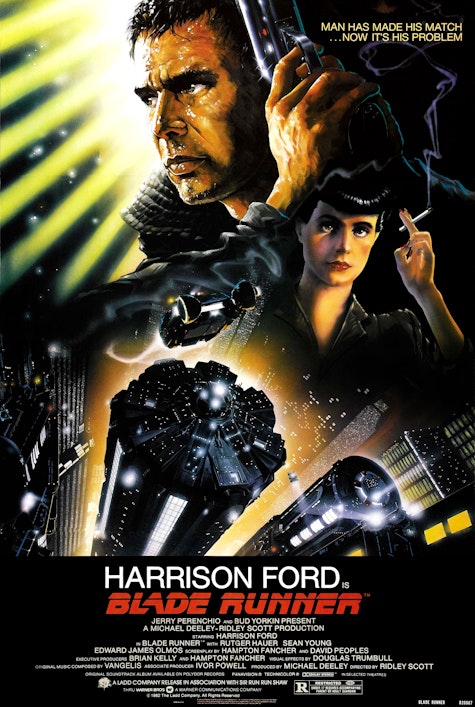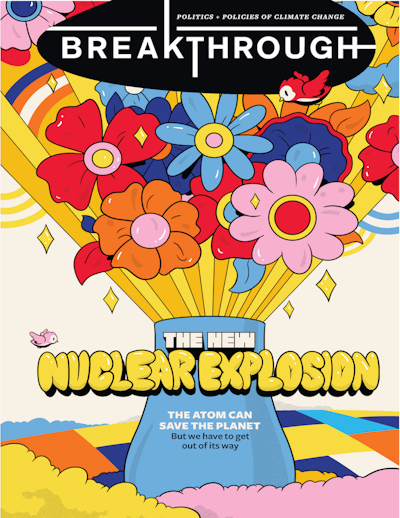Blade Runner at Forty
To address climate change, should we geoengineer the environment to be better for people—or engineer people to suit the environment?
-
-
Share
-
Share via Twitter -
Share via Facebook -
Share via Email
-
If it rained in hell, this would be the Los Angeles of the future.
It drizzles in the morning, and the evening. There is no sunshine, not even a solitary ray of light to relieve the gloom. The only illumination comes from the flames belching from smokestacks, the neon dazzle of billboards mounted on giant blimps and the probing spotlights of omnipresent police hovercars.

This year, 2022, marks the 40th anniversary of the release of “Blade Runner.” A classic science-fiction film of a dystopian future, “Blade Runner” appears to be more of a thriller than an environmental tale. But like many of its characters, the movie is deceiving.
Based on Philip K. Dick’s classic 1968 novel “Do Androids Dream of Electric Sheep?” the movie is set in Los Angeles in a fictional 2019, some 37 years in the future when the movie was released. “Blade Runner” depicts a society in which synthetic human beings—called “replicants”—have been created to perform dirty and dangerous tasks (“That’s Leon. Ammunition loader on intergalactic runs. He can lift 400-pound atomic loads all day and night.”). They are the slaves who power humanity’s colonization of the stars; the pioneers, miners, laborers, soldiers, assassins and prostitutes who keep society functioning.
Except that this society isn’t functioning. Housing on Earth is scarce and decrepit. Abandoned vehicles are strewn over streets crowded with people and prowled by gangs of thieves and roving police. The Los Angeles skyline is dominated by giant pyramids that serve as the headquarters of megacorporations. Overhead float airships with loudspeakers and digital signs urging emigration from Earth (“A new life awaits you in the off-world colonies! A chance to begin again in a golden land of opportunity and adventure!”).
And like any slave society, there is an undercurrent of fear. Replicants are engineered to be faster, stronger and smarter than their creators. So their masters have forbidden them to live on Earth upon pain of being “retired.” But sometimes, they go rogue. Now, the authorities are worried about four particular replicants who have hijacked a colonial spacecraft, slaughtered its crew and passengers and returned to Earth.
Enter Rick Deckard, a former blade runner, a human cop who hunts down replicants who have gone rogue. Deckard—played with hard-boiled cynicism by a young Harrison Ford—is forced out of retirement to locate and eliminate the four “skin jobs” who are mingling among the real human population.
But the search for humanity (or, rather, not humanity) is nonsensical in this world. What does it mean to be a real human, after all? It’s a deeply philosophical question, but in this frightened world, also a matter of arbitrary and instant death.
The main method this Los Angeles has found to identify replicants is by administering the Voight-Kampff test, where the interviewer asks questions that would theoretically evoke an emotional response only in a real person. But the questions themselves reveal more about society than the subject, as in a test that Deckard gives Rachael, a replicant who doesn’t know she is synthetic.
“You’re reading a magazine. You come across a full-page nude photo of a girl. You show it to your husband. He likes it so much he hangs it on your bedroom wall.”
“Is this testing whether I’m a replicant or a lesbian, Mr. Deckard?”
In some ways, the Voight-Kampff test doesn’t even matter, whatever it measures. Fearing that their superhuman creations would develop emotions such as hatred or jealousy, the Tyrell Corporation built an organic fail-safe system into their products: replicants would be genetically engineered to live no more than four years.
But the corporation failed to consider a basic contradiction. If replicants did develop human emotion—and realized that they only enjoyed the life span of a hamster—wouldn’t the will to live motivate them to somehow extend their life spans? And isn’t that fierce will to live a characteristic of people rather than machines?
Engineered People
“Blade Runner” would seem to be a tale of humanity, not climatology. No one ever complains—or even mentions—the weather. Indeed, the thought of nonstop rain in Los Angeles seems almost appealing as real California bakes under a long-term drought.
The Earth in “Blade Runner” has faced a different sort of climate change. If it’s always raining in southern California, then there is probably a drought somewhere else. The causes of that environmental shift are not made clear, but one look at these fictional California skies tells you that pollution must be a factor. Los Angeles doesn’t look like a futuristic apocalyptic fantasy as much as it looks like a horrid industrial town out of the 19th century, with slums abutting grimy factories and belching smokestacks.
Ironically, “Blade Runner” was released in the summer of 1982, when a record El Niño unleashed massive drought and rainfall across the globe. Scientists do warn of megafloods today, but in truth, 1982’s “Blade Runner” (not to be confused with the sequel, “Blade Runner 2049”) is more heir to dystopian films such as “Planet of the Apes” and “Soylent Green,” which depict an Earth wrecked by nuclear war or overpopulation.
While the environment is not a direct protagonist in “Blade Runner,” the visuals suggest that it is hostile. And a hostile earth creates a framework—or prison—that governs the characters.
On this Earth gripped by incessant rain and darkness, only fools, misfits and predators remain—essentially squatters, treated as rejects deserving of neither resources nor pity. “My glands, they grow old too fast,” laments a young scientist who is 25 but looks 45. “Is that why you're still on Earth?” asks a replicant. “Yeah. I couldn't pass the medical,” the scientist replies. “We’ve got a lot in common,” the replicant sighs. “Accelerated decrepitude.”
When the whole Earth is the enemy, sympathy seems almost unnatural. In a different telling, the replicants might seem heroic as they fight for the right to live. But they are not. They are scary, especially their leader, Roy Batty, an advanced Nexus 6 combat model memorably played by the late Rutger Hauer (who wrote some of his own dialogue).
The replicants are human in all the ways that we register humanity: howling in pain from a gunshot wound, expressing loyalty toward one another or even bonding with humans (as Rachael does with Deckard). They even have memories—borrowed from human people—that are implanted in their minds so that they feel less stressed.
But there is also a calculated, impersonal aspect to their personhood; they are slightly too laboratory-perfected. Do replicants really feel, or is that just a glitch in their programming? And how is it possible to spot the difference? “That Voight-Kampff test of yours,” cries Rachael, when Deckard tells her she is a replicant. “Did you ever try to take that test yourself?”
In this future, then, technology is in many ways the enemy. And what is left for humanity is a muddle. In the logic of a Darwinian universe in which Earth is uninhabitable and other worlds need to be formed, it makes a certain terrible sense to create synthetic people to do the dangerous work of terraforming other planets.
But the irony of the movie is that the replicants are also the beings that are best suited to live on an environmentally damaged Earth. And by the logic of “Blade Runner,” if you can create artificial humans that can survive on alien planets, then why not also respond to climate change on Earth by redesigning humans? If rain and darkness are a problem, then do we need geoengineering to bring back the sun, or do we need genetically engineered people who thrive in rain and darkness?
Technology As Cheating
We already see echoes of this in our world. Genetically modified foods are one of the greatest breakthroughs in human history. And we’re busy tinkering with supplements that can make cows belch less, with meat that grows itself and with food that takes longer to go bad.
Techniques to edit human genes are likewise established. Gene-editing therapies for some genetic disorders are in testing. A Chinese scientist was even jailed in 2019 for altering human embryos that became genetically modified babies. It may only be a matter of time before gene-editing is available on a broad scale, and even used to eliminate “undesirable” physical and mental traits.
From there, it may not be such a large leap to deliberately adapt people to their environments. Earth’s temperature heating up? Design people who like it hot. Water shortages? Design people who require less water. In some ways, that might be easier than colonizing other planets. While the rest of our solar system is inhospitable to human life without terribly elaborate means to keep people alive, people have been found in nearly every corner of our planet. To some extent, it happens naturally: people who live in high-altitude areas of East Africa or Nepal, for example, have a reputation for extraordinary performance as distance runners or for enduring low-oxygen environments.
The problem, of course, is the truly appalling ethics. Who would decide what genetic traits are necessary? Who would decide which are aesthetic? Is there any plausible way that this process of decision-making doesn’t end with races of servants and slaves?
Starting down this path would be an astonishing act of hubris, and as much as anything, “Blade Runner” is a parable about hubris. From the pyramid-headquarters of a corporation, a scientist played God. Synthetic humans revel in their mental and time-limited physical superiority. “Real” humans decide life and death on the most arbitrary assumptions of what it means to be human.
Ultimately, hubris is both a cop-out and a dead end. If humanity can respond to climate change by either fleeing Earth for other worlds or modifying humans to live on a hellish Earth, then there is no incentive to address climate change on earth.
And that is a good lesson for us today. “Blade Runner” is not anti-technology, but a warning not to let technology become a form of cheating. When humanity creates artificial people to do its dirty work, then it is admitting that the original homo sapiens are incapable of taking care of themselves. A slave society is a society insecure in its abilities and too ready to compromise its morals.
It is also a society that replicates its own problems. “Blade Runner” depicts a manmade hellhole, where people seem to have given up hope of making their world a better place. Flee to another planet? Those who ruined the original are just as likely to repeat their mistakes.
And that’s an unsentimental conclusion in an unsentimental world. But it does have poignant moments, and one of the most is the words of a dying Roy Batty: “I’ve seen things you people wouldn't believe. Attack ships on fire off the shoulder of Orion. I watched C-beams glitter in the dark near the Tannhauser Gate. All those moments will be lost in time like tears in rain.”
No one in “Blade Runner” can escape the rain—neither by fleeing nor by creating humans who don’t so much mind it—and neither can we.

